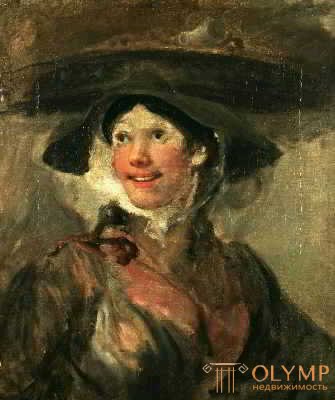
1. General overview of the development of English painting
English painting developed more intensively than all other areas of art. At the beginning of the century, another strong influence of foreign art was felt, but over time a number of prominent national masters who gained worldwide fame appeared.
The proud consciousness that British painting from the second half of the 18th century became an artistic world power finds expression in the English monographs about it by Edwards, Könningham, Fletcher, Hamilton, Thornbury, both Redgrews, Wedmore, Gower, and Armstrong, which appeared in the early 19th century. In France, Chenot wrote about her, in Germany, after various individual works, mainly Muter, who published his lively and fascinating "History of English Painting" in 1903. Only since the last decades of the XIX century, the whole of Europe began to admire the English painting of the 18th century, whose contribution to the treasury of art was sometimes even overestimated.
In the first half of the 18th century, the Stockholm portrait painter Michael Dahl (1656–1743) was followed by the English of the warehouse of the above-mentioned artistic critic Jonathan Richardson (1665–1745), who belonged to six conscientiously painted portraits of the National Portrait Gallery. . Richardson is followed by his pupil Thomas Goodson (1701–1771), whose portrait in the National Gallery depicting painter Scott is not deprived of certain warmth, and the Scot Allan Ramsey (1713 to 1784), simple, rather weak, but graceful in color, with a predominant in a cold pink tone, whose portraits are not far from real mastery, for example, the portrait of the Lady of the London National Gallery.
Among the historical painters of this period, we should mention at least the familiar architect William Kent. As a painter, he was a representative of such a weak, immature classicism that his altar image in the church of St.. Clement in London, ridiculed by Gogarth's caricature, was removed in 1725. English landscape painting also did not have a certain physiognomy. George Lambert (1710–1765) walked in the footsteps of the imitators of Dughet; Peter Monami (1670–1749), the first English marine marine painter, was an imitator of Willem van de Velde Jr. Samuel Scott (died in 1772), from whose works one view of the Thames was accepted into the National Gallery, was influenced by Canaletto.
English painting had a lot to make up for. Its rapid rise, beginning in the middle of the 18th century, no matter how nationally it was in spirit, was accomplished primarily on the routes indicated by the great Italians and the Netherlands of the 17th and 18th centuries. The turn to the Hellenistic anticuit only touched it later and then quickly moved on to direct observation of nature. During all its heyday in the XVIII century, English painting, despite its retrospective eclecticism, remained the daughter of not only its time, but also of its people. English is already an area of plots, where portrait painting is still the alpha and omega, and the native landscape and native life come into their own right next to it. In English, her predilection for a noble and graceful tone is manifested in the framework of a warmly felt home life. Hence the famous decorative feature that distinguishes it. The colors of the landscape and portrait surroundings repeat, for the sake of the “picture effect”, often only too deliberately chosen colors of the costumes of the depicted persons. But since they are true whole personalities, they invariably attract to themselves.

Fig. 235. "Crab Saleswoman". William Hogarth painting in the National Gallery in London
Five extremely different artists, Hogarth, Wilson, Reynolds, Gainsborough and Romney, expressed the first heyday of English painting. The eldest of them is the bold and self-conscious art nugget William Hogarth (1697–1764). Hogarth is primarily a realist. Observation of life stood in the first place for him. The “line of beauty” that he demanded in his essay “Analysis of Beauty”, which appeared in 1753, was a concession to the spirit of the times. The last big work about him belongs to Dobson. No less skillfully than a brush, he owned grabstih, needle and strong vodka. The basis of his art is the uncompromising desire to truthfully and gracefully throw his conscientious observations onto the plane. And he began with portrait painting. His self-portrait with a dog, six heads of servants, striking in their purely pictorial merits, The Crabmistress is all in the London National Gallery; The portrait of Baron Lovat of the National Portrait Gallery shows his portrait talent from the best sides. "Captain Coram" in the London Educational Home (1739) is one of the best portraits in the world. Weak big wall paintings "The Merciful Samaritan" and "The Healing of the Blind" (1736) on the stairs of the St. Bartholomew does not characterize Gogarth as a historical painter as well as the boldly depicted “Procession in the (London) Suburb of Finchley” (1750) and his original “Finding Moses” (1752) in the Educational House in London.
Game: Perform tasks and rest cool.6 people play!
Play game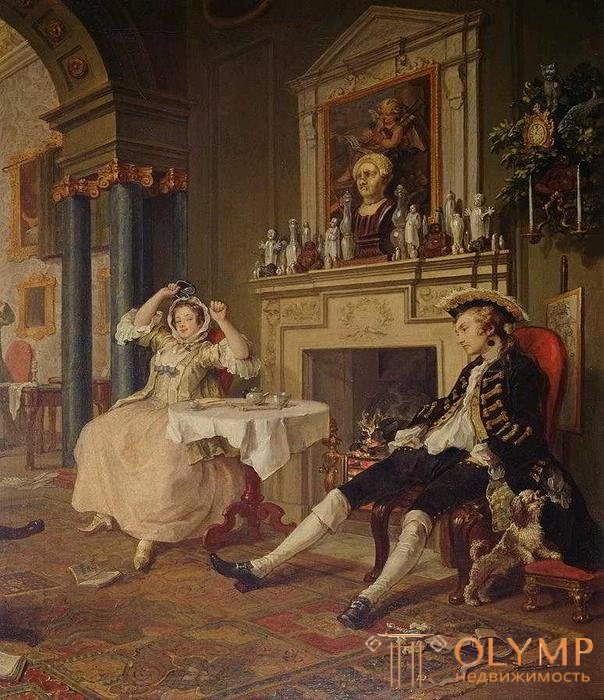
Fig. 236. "Shortly after the wedding." A painting by William Gogarth from the Fashion Marriage series at the National Gallery in London
Hogarth's famous painting "The Gate of Calais" (1749), in the National Gallery, which already constitutes a transition to genres, is not inferior in terms of painting power to at least Goya.
Game: Perform tasks and rest cool.6 people play!
Play gameNext age was landscape painter Richard Wilson (1713 to 1782), whose biography was written by Wright. Originally a portrait painter, Wilson developed in Italy (1749–1755) in the paintings of Poussin and Claude in the “English Claude Lorrain”. The breadth of the line and the balance of the composition distinguish its landscapes as much as their designs. But Wilson was also able to communicate to his ideal landscapes the aroma of spontaneous and in English heartfelt mood. Of his paintings in the National Gallery, the mythological plot has an even larger ideal landscape with “The Death of Niobids”, somewhat reminiscent of Salvator Rosa. But the pandan to this picture, “Villa Patron”, resembling Poussin, is nevertheless a typical work of Wilson, since it is free from any mythology. Particularly majestic clouds gathering in the sky, half illuminated by the sun. Small Italian landscapes and an even smaller English river landscape with bathing boys in the sunlight, despite their styling, are clear and true in form and color. The large river landscape with ruins, acquired by the gallery only in 1900, was filled with a particularly warm light only in 1900. Romantic in the mood of his big picture in the collection of Lord Northbrook in London, the flaming colors are different "Sunset" in the Edinburgh Gallery. The best of his paintings are of lasting importance in the history of painting.
2. Outstanding English portrait painters
The most famous English portrait painters of the 18th century are Joshua Reynolds and Thomas Gainsborough. Both of them began to develop under the influence of Italian and French art, and over time they moved on to national motives in their work. The painting of Reynolds is in many respects close to the Baroque style, whereas Gainsborough worked in a manner close to Rococo
Creativity Reynolds
Of the three other main masters of English art, Sir Joshua Reynolds (1723–1792), the first president of the Royal Academy of Arts founded in 1768, was the most versatile and scholarly, most self-confident and consistent. Armstrong wrote a monograph about him. When Reynolds teacher Goodson ceased to satisfy him, he diligently engaged in copying Rembrandt paintings. The most mature fruit of his Rembrandt studies is a youthful self-portrait with a hat in the National Portrait Gallery. Then he was drawn to Italy, where he stayed from 1749 to 1752; here he developed into a conscious eclectic. Michelangelo became his idol. But in the executives he himself chose mainly Bolonians and Venetians. In a most thorough way, he deepened into the study of the colorful techniques of the old masters; he left nothing without attention; the rational basis of his art is everywhere. In his historical paintings, he barely rises above the level of eclecticism; here, as if by the whim of the artist, Rubens' forms are combined with Titian paints and with Korardzhiev chiaroscuro. Typical specimens of this genus - “St. Family ”of the National Gallery,“ Scipio's Temperance ”in the Hermitage,“ Hope that Feels Love ”in Bowwood. His most famous mythological painting, “The Snake in the Grass” at the National Gallery, depicts the god of love, unleashing a girl’s “belt of beauty”. An excursion to the area of romance is a new one for that time, striking in its horror the picture: “Count Ugolino in the Tower of Hunger”, located in the gallery of the city of Zero, in Kent.
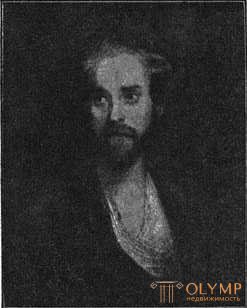
Fig. 237. "The Exiled Lord." Joshua Reynolds painting in the National Gallery in London
As a portrait painter, Reynolds combined direct observation of what he had seen with a sublime, magnanimous mood, deploying on this basis all the spells of his dazzling pictorial eloquence; and although in the allegorical content and in the surroundings of other portraits, he showed himself quite the son of his time, but other portraits, for example, the “Expelled Lord” of the National Gallery, were performed with a direct, heartfelt emotional depth. He created a mass of truly whole natures; His children's portraits especially breathe with rare freshness and naturalness.
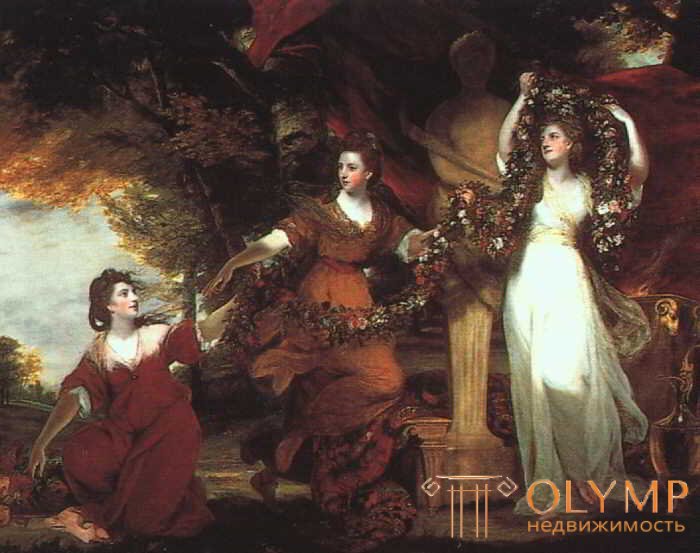
Game: Perform tasks and rest cool.6 people play!
Play gameFig. 238. "Three sisters of Miss Montgomery crowned Hermes Hymen." Joshua Reynolds painting in the National Gallery in London
Upon the return of Reynolds from Italy, the general attention was aroused in 1753 by his portrait of Captain Keppel, now in the collection of Lord Rosbury in London. Here, for the first time, the figure depicted on the canvas was not a figure or head, but a living organism. The time period from 1753 to 1765 embraces the first period of maturity of the artist. This time belongs to the magnificent, simple and fresh portraits, including Kitty Fisher in the collection of Count Crew (1759) and the famous portrait of Nellie O'Brien (1763) in the Wallace Gallery, then the portrait of Pastor Lawrence Stern (1760), owned by Marquis Lensdown, and the actor Garrick among the figures "Tragedy" and "Comedy", in the collection of Lord Rothschild in London.
Between 1765 and 1775 the postures of the figures in the portraits of Reynolds become more calculated, the coloring more refined, the draperies more careless, the staffing more contrived. These include: “Lady Sarah Bönbörri, sacrificing graces” (1766) and “Lady Black as Juno, with which Venus gives the belt”, belonging to Sir Henry Bönbury, Mrs. Gartley, as a nymph, with her son, as young Bacchus , in the collection of Lord Northbrook (1772), sharp in colors, somewhat fake picture "Three sisters of Miss Montgomery crowning the Hermen of Hymen" (1775) of the National Gallery, here also belong the pretty "Girl with strawberries" (1771) in the Wallace Gallery, little Francis Crew walking across the field in a raincoat and with a basket through the arm (1770), in the collection of Fa Crew, and a charming picture in Windsor Castle, depicting a little princess, lying on the ground with a dog (1773).
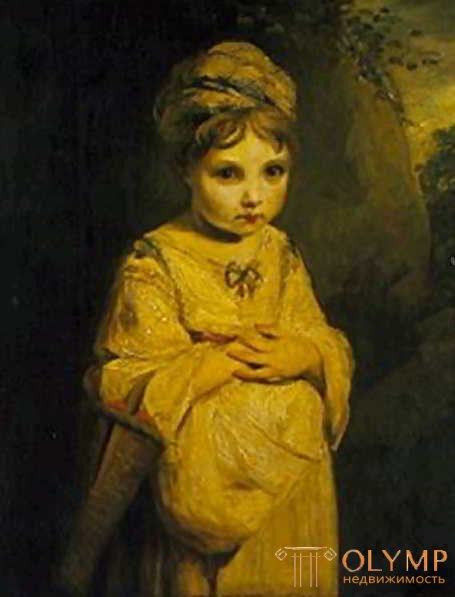
Game: Perform tasks and rest cool.6 people play!
Play gameThe most mature period of Reynolds’s work is the last sixteen years of his life. A deep understanding of the persons portrayed is increasingly becoming its most important quality. The gorgeous colors of clothes are draped again more carefully. The landscape background still retains only a side, purely decorative value. But all particulars are combined into one large, harmonious whole. From a long series of masterpieces, a fresh portrait of Little Crew (1775) in the collection of Count Crew stands out, dressed with gray and gold by Lady Crosby (1778) with Sir Charles Tennant, an amazing “Schoolboy” (1779) in Warwick Castle, a deeply inspired portrait Lord Terlo (1781), owned by Marquis Bass, and a strikingly powerful portrait of Lord Hisfield with the key of Gibraltar in hand (1787) in the National Gallery. The best portraits of the great actress Miss Siddons in the form of a tragic muse on a throne soaring in the clouds, behind which are personified dramatic passions (1784), in Grosvenor House, Duchess of Devonshire with her lively little daughter on her knees (1786), in Chetsworth Castle (1786), in Chetsoors Castle (1786), ), and a delightful "Innocent Age" - sitting in the grass with her hands folded on her chest (1790) in the London National Gallery.
Only Reynolds himself never wanted to be; but nevertheless his great personality is immediately visible in his best works.
Creativity Gainsborough
Four years younger than Reynolds was his great rival Thomas Gainsborough (1727–1788), surpassing his originality and spontaneity of artistic nature. In Reynolds, baroque XVII is felt more, in Gainsborough - rococo of the XVIII century. For Gainsborough, about which there are good books by Fulcher, Armstrong, Mrs. Bell and Pauli, the original old masters seemed not to exist at all. He began by painting the landscapes of his provincial Suffolk homeland. Having become acquainted (after 1760) with the paintings of van Dyck, he began to diligently copy them. Van Dyck became the guiding star of his art. However, he himself had a stronger sense of truth and beauty than Van Dyke. He saw the English women and the English landscape with his own, English eyes and depicted them with a wide, healthy, over the years becoming more and more light, more and more “impressionistic” brush. His portraits are usually in closest relations to their native landscape, and landscapes often inadvertently turn into a genre, or the animals on them from the neighborhood to the main image.
The first independent period of creativity of Gainsborough (1746–1758) was spent in Ipswich, among the trials and experiments, which were first groped and gradually became more confident. Of the early paintings, the National Gallery has a beautiful, somewhat dryly painted double portrait of his daughters, one of whom catches a butterfly, and a beautiful landscape known as the “Kornard Forest”, which, in spite of or because of the distribution of trees on it resembles Gobbema, remains the freshest on the sense of nature of all its landscapes.
The second period of his work (1758–1774) was spent in a more lively artistic environment and in a better life situation in Bass. Here, for the first time, portraits appeared so diligently, almost sugary, and illuminated, for example, Orpin's reader reading the Bible, in the National Gallery. The bold portrait of Georgiana Spencer (1762) belonging to Earl Spencer in London is distinguished by graceful simplicity. A figure in the growth of musician Fisher in Hampton Court and a half-figure of the actor Coleman in the National Gallery breathes warm life. Probably as early as 1770, the famous “Blue Boy” appeared in Grosvenor House: an en face portrait of a young Bethal, with warm tones of a body in a blue fantastic costume, against a landscape in a brown tone — a real miracle by nobility of design and by a kind of colorful effect; рядом с этим «Голубым мальчиком» может быть поставлен «Розовый мальчик», портрет мальчика, одетого в розовый атлас, в собрании барона Фердинанда Ротшильда в Лондоне.

Fig. 240. Портрет Джорджианы Спенсер работы Томаса Гейнсборо, принадлежавший графу Спенсеру в Лондоне
Game: Perform tasks and rest cool.6 people play!
Play game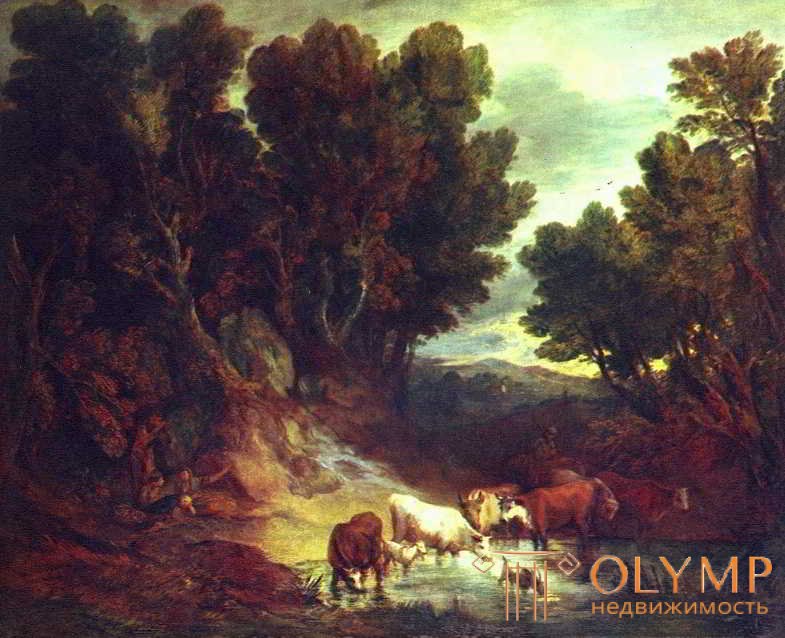
Fig. 241. «Водопой скота». Картина Томаса Гейнсборо в Национальной галерее в Лондоне.
Game: Perform tasks and rest cool.6 people play!
Play game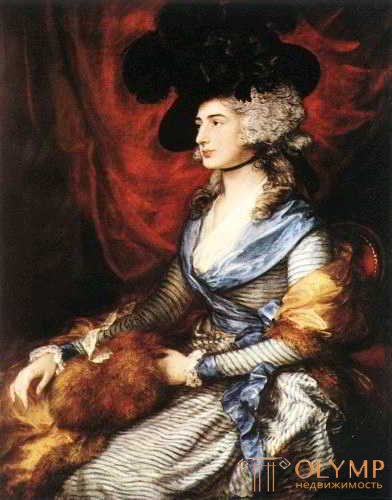
Fig. 242. Portrait of Mrs. Siddons by Thomas Gainsborough in the National Gallery in London.
The large portrait group of the Bali family, in the same gallery, refers to the last period of Gainsborough's activities. The poses of the figures are forced and intentional, but the enchanting colors of this picture and the airy, light letter impart to her high pictorial virtues. Excellent as the landscape is not very large in size oval picture in Windsor Castle, representing the "Morning Walk" of the Duke of Cumberland and his wife. Completely landscaped in nature is an excellent, reminiscent at the same time of Watteau and Monet, “Picnic” near the Park of Saint-Jem, owned by Sir Algernon Nild. A worthy place along with this picture is occupied by the magnificent marina in Grosvenor House. Landscape painting has always been Gainsborough's secret love.
Other English portrait painters
The fifth in the series of these pioneers of English painting was George Romney (1734–1802), a detailed description of which is given in a two-volume work by Ward and Roberts. To the great masters began to rank him only recently. Returning in 1775 from Rome, where he absorbed false classical ideas, he became a portrait painter in London and competed with Reynolds and Gainsborough because of the favor of customers. In his portraits, you can easily recognize the grandson of classicism in the plastic of the figures and in the drawing. He was, moreover, the best pictorial figure of the “beautiful Englishwoman,” as we used to imagine her, healthy and languid at the same time. His portraits are painted clearly and firmly, but by no means angular or dry. With clear local tones, they are distinguished by a subtle, at times, however, somewhat reddish shade.
The London National Gallery has eight pictures of Romney, but none of his real masterpieces are: Lord Gower's Children, dancing hand in hand in the collection of the Duke of Sutherland, or a portrait of Mrs Ressel with his child by Sir George Ressel in London. His false classical basis appears in the “Lady Warwick with Children” group and in “Miss Vernon in the form of Hebe”, owned by Lord Warwick, as well as in the portrait of Lady Hamilton, in the form of the Bacchante, in the National Gallery.
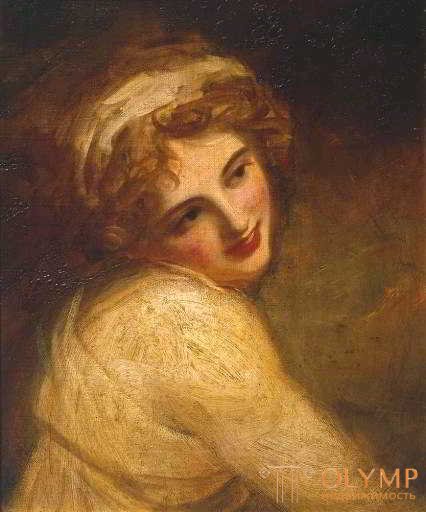
Fig. 243. "Lady Hamilton in the form of a bacchante." Painting by George Romney at the National Gallery in London.
The most significant British portraitist of the younger generation of artists, who appeared in the second half of the century, was the Scotsman Sir Henry Reiburn (1756–1828), who visited Italy before it was founded in Edinburgh. Armstrong's biographer, Reiburne, attributes his main feature mainly to the impression made to him in Rome by Innocent X by Velasquez. In spontaneity, freshness and breadth of design, in captivating warmth and vividness of tones and colors, only a few can equal it. Among the best things in the Edinburgh Gallery are portraits of Mrs. Campbell, John Wilson with a horse and a self-portrait of the artist, in the Edinburgh Shooting Hall a striking full-length portrait of Nathaniel Spens, drawing a bow, in the Glasgow Museum, a portrait of Sir John Sinclair, in the London National Gallery of the ladies in the swan hat, in Dresden portrait of Bishop Lucius O'Birn. A feature of time was that Rayburn moved from a greater breadth and freedom of the hand to a more solid and solid letter.
The portraits of mainly Reynolds developed the talent of London native John Goppner (1759–1810), the masters depicting beautiful red-cheeked Englishwomen, whom he wrote in clear and cold colors, in fresh love performance. The portrait of the Countess of Oxford in the National Gallery still belongs to his best works. The latter are in private collections. Four children of Douglas are famous in the collection of Lord Rothschild in London.
Game: Perform tasks and rest cool.6 people play!
Play game3. Historical painting in England
In the second half of the century in English painting stands out the historical direction, which is closely associated with the romanticism that began to gain strength. Significant contribution to this direction make North American artists. In addition, graphic art is developing intensively.
Great efforts were made in the 18th century in England to create a national ascent also in the field of historical and narrative painting. The book publisher, alderman, and later the lord mayor of London, John Boydel (1719–1804), introduced the painting of illustrations, which then flourished in the XIX century for so long. He founded the Shakespeare Gallery, for which, according to his order, the most outstanding English painters produced paintings; these paintings were reproduced in the famous large album of engravings for which even Reynolds and Romney wrote originals.
Game: Perform tasks and rest cool.6 people play!
Play gameHis largest enterprise is six large paintings illustrating the history of the development of human culture, with which he decorated between 1777–1783. London Art Society, where they are now. Roman relief style is the highest goal here. But how thin the nude muscles of the depicted figures seem to be! In these paintings, the offspring recognizes only the serious intentions of the artist.
On the basis of romanticism were the main artists of the Bodel shakespearean gallery: John Opie (1761–1807), the best picture of which “The Murder of Rizzio” (Italian musician, favorite of Maria Stewart, stabbed in front of her eyes in 1566 - Approx. Translation) is in the town hall The city, then the Zurich native Heinrich Füsli or Füsseli (1748–1826), is a talented, somewhat unbridled science fiction writer with Michelangelo false classical forms. In his "Titania" in the National Gallery, one of eight creepy tragedy paintings on the themes of Shakespeare's themes by James Norskot (1746–1831), of which nine Shakespearean paintings are most known, "Murder of the Children of Edward IV", is preserved. Robert Smerk (1752–1845), after paintings for scenes from the works of Shakespeare written for Boydel, made a number of talented illustrations for Don Quixote in the National Gallery. At the end of this series stands Thomas Stosard (1755–1834), of the fifteen paintings of which at the National Gallery is especially famous for the “Pilgrimage to Canterbury”. Of all these painters, Heinrich Füsli, who in 1782 set up the fantastic nightmare for the painting, and in 1789, the huge dark picture of The Shadows of the Underworld, is a true artist by the ingenious power of his imagination.
Greater, lasting dignity than the specified English historical painters, have English landscape painters, following Gainsborough. The true artist was George Moreland (1763–1804). Full of mood, harmoniously felt landscapes of his and genres from the animal world closely resemble Gainsborough. Yellow-gray, silver tone distinguishes his best paintings, such as “The Stable”, “Fighting Peasants” and the landscape of the dunes of the National Gallery. A more significant artist was Old Crom, John Crom of Norwich (1768–1821). Numerous landscapes of it, with all the simplicity of the majestic, with all the accuracy of gentle tone, sometimes reminiscent of Cape, sometimes Salomon Reysdal, remaining nevertheless completely English. How wide, warm and sunny is its landscape with a windmill on a hill, how simple and monumental it is in its “Breaking Slate” lines, how much mood is in the air, despite the carefully foreground flowers, in the Mausgold Forest, in the National Gallery! His students and like-minded people form an outstanding “Norwich school” belonging to the nineteenth century.
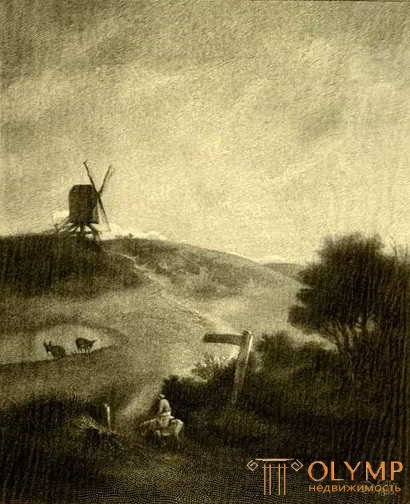
Fig. 244. "Landscape with a windmill." A painting by John Crom at the National Gallery in London.
The landscape became a point of departure for the important in its significance English watercolor painting, processed in the special writings of Kyndahl and Finbury. Since watercolor is mostly performed to the very end before nature itself, it is ahead of oil painting with its correct transmission of light air and light tones, not obscured by any worries about the “gallery tone”. Its gradual development can be traced in the British and South Kensington museums. Its pioneers are Paul Sandby (1725 to 1809), John Robert Cozens (1752–1799), in which the Constable recognized his predecessor, and Thomas Gerten (1773–1802), who had a significant influence on Turner. The rapid spread and special significance of this art led already in 1805 to the foundation of the London Society of Painters with water colors.
English engravings
Game: Perform tasks and rest cool.6 people play!
Play gameWilliam Blake, a talented poet, draftsman, and copper engraver (1757–1827; Lendridge’s book), who became the greatest born English artist of his time, developed under the mutually complementary influences of Füsli and Flaxmann. Characterized by his illustrations to Jung's “Night Thoughts”, his 24 engravings to the book of Job, 100 extraordinarily fantastic drawings to Dante's “Hell.” He consciously preferred the angular forms of the pre-Raphael time. It is not surprising, therefore, that he was so highly placed by the later British Pre-Raphaelites, like Dante Gabriel Rossetti, and that he is in a certain sense a contemporary artist for us.
Youthful fresh British art of the XVIII century imperceptibly into the art of the XIX century. The brilliance of the art of the “century of enlightenment,” which in most other European countries was like the evening dawn before the new day, was in England the dawn of a young day.
Что бы оставить комментарий войдите
Комментарии (0)